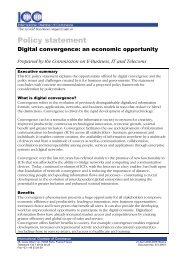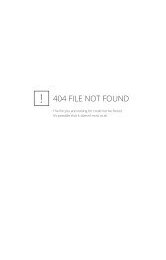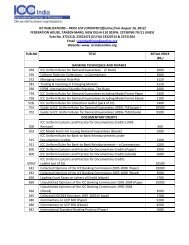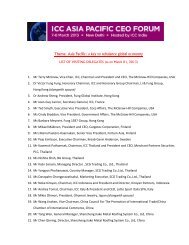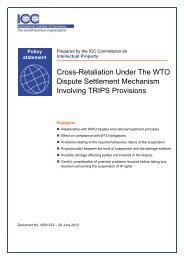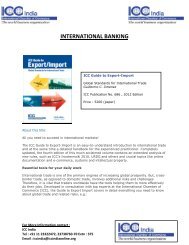2013 - ICC India
2013 - ICC India
2013 - ICC India
- No tags were found...
Create successful ePaper yourself
Turn your PDF publications into a flip-book with our unique Google optimized e-Paper software.
<strong>ICC</strong> BANKING COMMISSION | <strong>2013</strong> GLOBAL RISKS TRADE FINANCE | INTRODUCTION 11■■■■Across-the-board increases in capital and improvements in its quality:The overall amount of high quality 7 capital held by many banks, such asretained earnings and paid-in capital, was found to be inadequate duringthe crisis. However, under Basel III, banks will need to hold more highquality capital.Minimum capital requirement due to cap on leverage: The minimumamount of capital that must be held against any exposure is set at 3%(on or off balance sheet). For most instruments, the capital requirementwill be above this regulatory minimum. However, the capital requirementfor short-term off balance sheet trade finance instruments, such asL/Cs, will typically be lower than the regulatory minimum. This couldpotentially dramatically increase the amount of capital required forshort-term off balance sheet trade finance instruments.1.4.2. Liquidity requirementsRequirements for the liquidity of FIs have also been strengthened by the BaselIII regulations through the introduction of the Liquidity Coverage Ratio (LCR)and the Net Stable Funding Ratio (NSFR).The LCR is a measure designed to ensure that a bank can still meet all itsobligations, such as making payments and allowing cash withdrawals, forat least 30 days, even if its normal sources of funding are cut off or if thereis a run on the bank. Banks are expected to hold a part of their assets inthe form of cash and securities, like government bonds, that are easilyconvertible into cash. For contingent obligations stemming from tradefinance instruments, a low run-off rate of 5% or less is suggested by theBasel Committee and might be a good benchmark before the final decisionsare made by the national authorities. For medium and long-term ECA loans,the mitigation factor of 10% to 40% on the off-balance sheet commitmentsintroduced in January <strong>2013</strong>, will also have to be confirmed.The NSFR attempts to ensure that the maturity of assets and the liabilitiesfunding them are well matched in order to enhance stability. The NSFR isbased on prescribed assumptions on the liquidity characteristics of variousbalance sheet items. It requires that 85% of short-term lending to SMEsand 50% of short-term lending to corporates must be funded by longtermliabilities. This means that short-term on balance sheet trade financeinstruments, such as invoice finance, will become more expensive to fund,since long-term funding usually costs more than short-term funding. Thereare no proposals as yet for off balance sheet exposures like L/Cs, which areleft to the national authorities.Based on its evaluation of the impact of Basel II and III on trade finance inthe context of low income countries, the Basel Committee decided to modifythe capital treatment of trade finance in two areas: (i) the exemption ofissued, as well as confirmed, trade related L/Cs from the one-year maturityfloor; and (ii) a reduction of the capital charge levied against trade loansto countries with low sovereign debt ratings. While these revisions shoulddefinitely support trade finance and soften the impact on emerging markettrade flows, they are expected to remain modest in impact compared withthe implications of increased capital and funding costs on global trade flowsas per the current Basel regulatory proposals.



